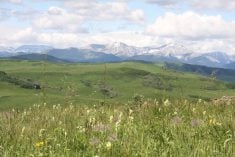There has been plenty of talk in grain markets about how dismal growing conditions could reduce Ukraine’s 2012-13 winter wheat crop.
However, there has been little chatter about two other winter crops of interest to Canadian growers: rapeseed and barley.
Winter grain comprises half of Ukraine’s seeded area, and about a third of the crop is entering winter in weak condition because of “unusually and persistently” dry weather, according to a recent Commodity Intelligence Report prepared by the U.S. Department of Agriculture.
Read Also

VIDEO: Case IH reveals new Optum tractor at Agritechnica 2025
Case IH reveals its new Optum tractor at Agritechnica 2025.
Fall precipitation was the lowest in recent history, resulting in inadequate surface moisture levels and the expectation for extensive winterkill.
Ukraine’s agriculture ministry said Dec. 26 that only 80 percent of fall planted crops had germinated compared to 93 percent last year at the same time.
Of the crops that had sprouted, 34 percent was in poor condition and the rest was satisfactory to good.
The government thinks 3.7 to 4.9 million acres of winter crops will need to be replanted in the spring, but the full extent of damage won’t be known until the end of winter.
“Rape is the winter crop most susceptible to winter damage, and winterkill is significantly higher for rape than for wheat and other grains,” said the USDA.
Growers planted an estimated 2.25 million acres of rapeseed, down 19 percent from the fall of 2010.
Greg Kostal, president of Kostal Ag Consulting, said Ukraine exports all the rapeseed it grows, and any disruption could be an opportunity for Canadian canola.
“Europe would need to import more canola or more canola oil to make up the difference,” he said.
An increase in spring planting could make up for some of the lost winter rapeseed, but the spring rapeseed crop is typically much smaller, so a complete recovery is unlikely.
Kostal is particularly intrigued about what will happen with Ukraine’s winter barley crop, which accounted for more than 30 percent of the country’s nine million tonnes of barley production in 2010-11.
Ukraine has been the world’s largest barley exporter in four of the last five years, accounting for an average of 4.4 million tonnes of the 17 million in annual global barley trade.
“If you have any hiccup in that part of the world, it has a more pronounced impact on world price,” said Kostal. “It’s sure something to watch.”
Markets will also be monitoring how Ukrainian farmers respond in the spring.
Barley has traditionally been the crop used for spring reseeding if there has been winterkill, but Ukrainian agriculture officials and private commodity analysts believe corn and soybeans could make up a large portion of the reseeded area in 2012.
Kostal will also be following how the Ukrainian government responds to the potential grain shortfall.
In the past, it has relied on export bans and tariffs to keep supplies at home, which could result in a decline in what Ukraine has to export.
The other crop of interest to Canadian growers is wheat, which accounted for 81 percent of 2012-13 winter crop plantings, or an estimated 16.1 million acres. However, winter wheat is a remarkably resilient crop that can recover if spring growing conditions are favourable.
As well, plenty of wheat is in storage around the world, so a supply shortage in Ukraine might not have a dramatic impact on global wheat prices.















